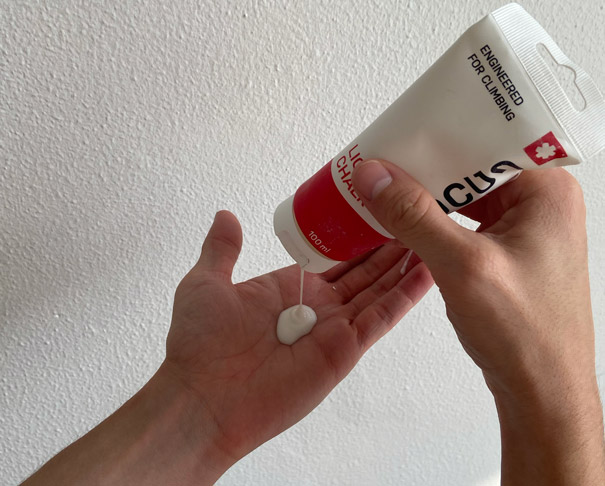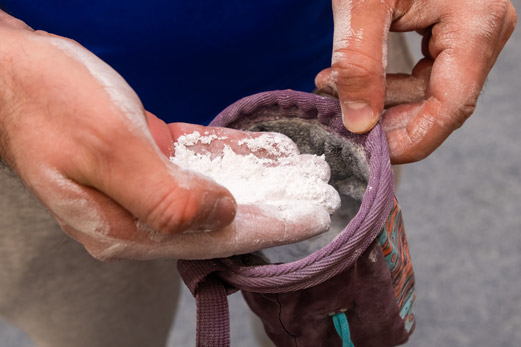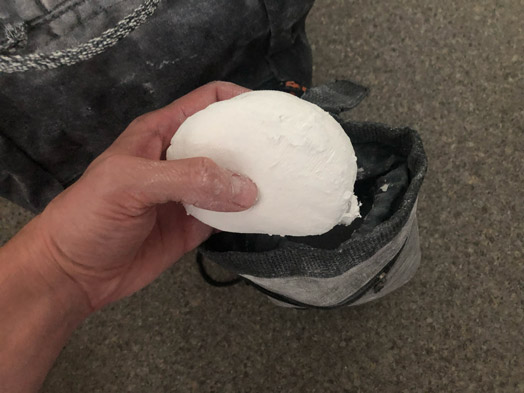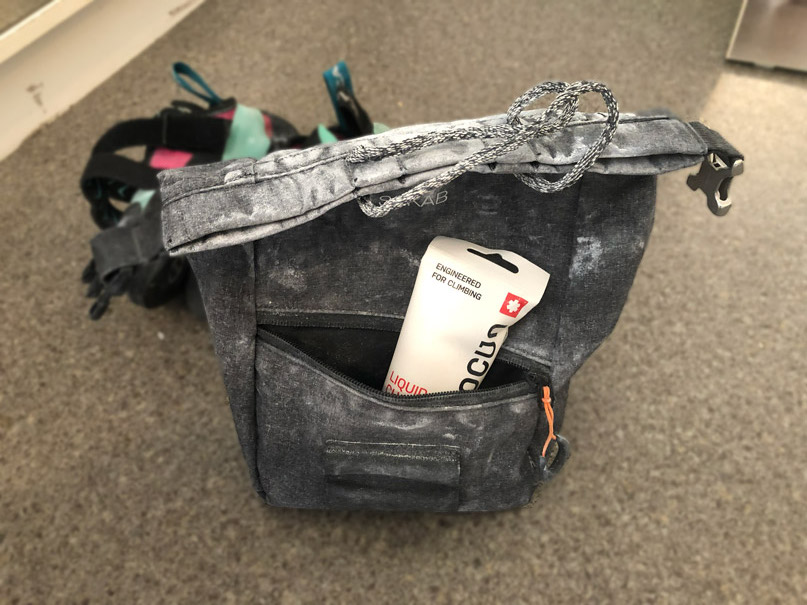Chalk will help dry out your hands and give you more grip during your climbing session. If you are lucky, your climbing gym might let you rent a chalk bag. However, this isn’t always the case. In many climbing gyms, you have to either bring your own chalk or purchase chalk from them.
There are three types of chalk:
- Liquid chalk
- Loose chalk
- Chalk ball
Each of these chalk options comes with its own advantages and disadvantages. Some are better for sweaty hands (like liquid chalk) while others are better for your skin (like fine, loose chalk).
Liquid Chalk

Liquid chalk is alcohol-based and comes in a tube or bottle. This chalk solution is antibacterial, doesn’t release dust particles, and is really good at drying out the hands. Application is easy, imagine you are rubbing sun lotion on your hands, and carrying it around the bouldering gym is easy due to its small packaging.
The disadvantage of liquid chalk is it takes about a minute for the chalk to dry out. Additionally, the drying agent in liquid chalk isn’t great for climbers who struggle with eczema or other sensitive skin issues.
Liquid chalk is sold in most bouldering gyms.
We recommend liquid chalk to beginner boulderers because it’s easy to apply, very good against sweaty hands, easy to carry around, doesn’t spill, and doesn’t require a chalk bag. The ideal solution for anyone who is just looking to have a good time on their first couple of bouldering sessions.
powdered Chalk

Loose chalk is powdered chalk that sits inside a chalk bag or bouldering bucket. This powdered chalk comes in many variations which can benefit different types of hands (sensitive, sweaty, non-sweaty) and different types of climbing styles.
Loose chalk is favored by most climbers because of how quickly you can apply it. Simply stick your hand inside your chalk bag and you are good to go.
Loose chalk has one big disadvantage: they pollute the climbing gym with its dust particles. Breathing in dust particles isn’t good for your health or others. It also causes people to cough.
Chalk Ball

The chalk ball also referred to as ‘chalk sock’ is a small net that has loose chalk inside of it. With chalk balls, the idea is to squeeze them and your hand will be coated with chalk. This is a quick and easy solution. With chalk balls, you never have to worry about how much chalk you have to put in your chalk bag.
Chalk balls sit inside a chalk bag. They are super cheap and last for ages. My girlfriend swears by chalk balls as they are easy to use and don’t trigger her eczema as much as liquid chalk or chunky loose chalk.
Use a Chalk Bucket for Bouldering
Indoor Bouldering has risen in popularity over the last couple of years. This influx has caused a large chunk of climbers to not participate in any form of roped climbing.
Boulderers will benefit from using a bouldering bucket (which is essentially just a large chalk bag) over using a smaller chalk bag that attaches to the waist. Boulder buckets are much bigger, can rest on the mat upright, and have pockets to hold your belongings as well as straps to hold your brushes.
The bouldering bag offers a way to safely store your belongings such as car keys, your phone, and wallet but also your climbing equipment such as tape, liquid chalk, and brushes so you always have these items with you while you are bouldering. Furthermore, its big opening allows both your hands to fit inside the bag which causes less spillage.
Boulder Buckets are a big upgrade from a smaller chalk bag as a boulderer and are recommended to anyone who doesn’t yet have a chalk bag and favor the indoor bouldering hall.

More articles like this
- Indoor Bouldering Basics: intro to gym climbing
- Tips for short climbers
- Complete Guide to Bouldering Grades (& conversions)
- How to start and finish a boulder problem
- Can I get abs from climbing?
- Bouldering vs rock climbing
- How often you should go bouldering per week
- Why bouldering is a good full-body workout
- Climbing 101: what is cutting feet?
- How long does it take to progress in bouldering?
- How much does it cost to start bouldering?
- What to wear indoor bouldering
- How much of a bouldering wall can you use?
- Should climbing shoes hurt?
- How many climbing shoes do you really need?
- Yoga for climbers
- Core workout for climbers
